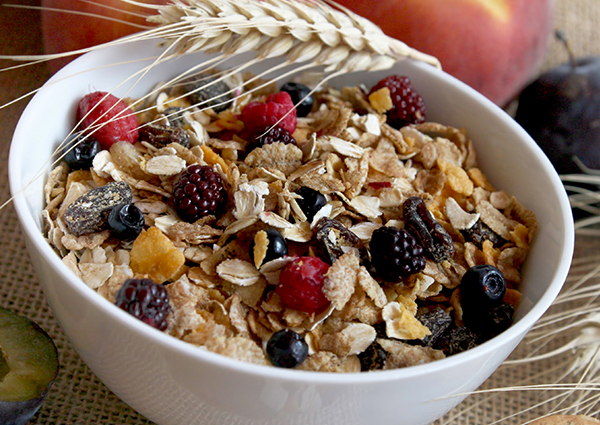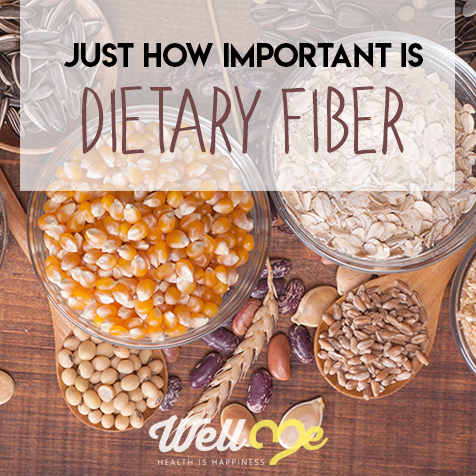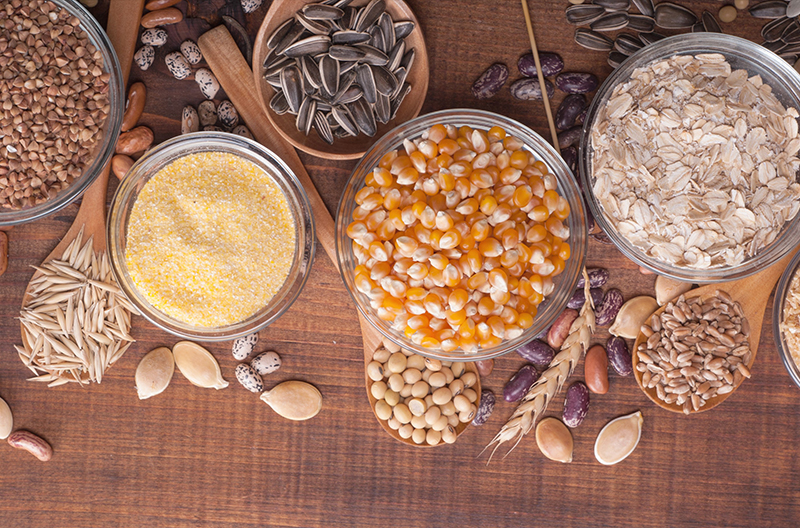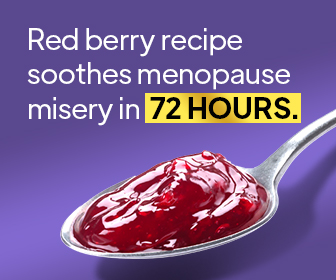Dietary fiber – you know it is an important part of a healthy and balanced diet. But what is dietary fiber, and how much of it do you need?
In this article, you’ll receive an in-depth guide to dietary fiber including what it is and how much you need. More than that, however, you’ll receive insight into how to optimize your fiber intake to achieve the ideal balance of soluble and insoluble fiber.
Wondering if there is such a thing as too much fiber in your diet? It is possible! Keep reading to learn everything you’ve ever wanted to know about fiber and the symptoms of excess fiber intake.
What is Dietary Fiber?

So, what is dietary fiber? In the simplest of terms, fiber is the part of the plant your body is unable to completely digest. It is also sometimes known as the roughage. Fiber can be found in all plant foods including fruits, vegetables, nuts, seeds, beans, and grains[1].
Not only can fiber be found in a wide variety of foods, but it comes in different forms. There are two forms, specifically: soluble and insoluble. Here’s how you tell the difference:
Soluble fiber swell as it absorbs liquid in the digestive tract and it provides a source of food for the bacteria in your gut. As beneficial bacteria feed on the fiber, it ferments and gives you a feeling of fullness. Soluble fiber can be found in certain seeds, and berries as well as oats, beans, lentils, and barley. This type of fiber helps to lower your bad cholesterol and it is important for colon health.
Insoluble fiber is primarily found in the skins of fresh fruits and vegetables as well as certain grains like wheat, rye, and rice. This type of fiber doesn’t dissolve easily in water (hence the name insoluble). Instead, it adds bulk or mass to your stools. Insoluble fiber is essential for healthy and regular bowel movements.
Fun Fact: According to a 2016 article published in the journal Nature, dietary fiber intake can actually impact the microbiome in your gut, leading to reduced diversity. Your microbiome is simply the collection of microbes in your body (particularly your digestive tract) which contribute to healthy digestion as well as immunity. Low dietary fiber intake can kill off those beneficial microbes.
Now that we’ve answered the question, “what is dietary fiber” and you’ve learned where it can be found, take a moment to think about how much fiber you get in your daily diet.
How Much Fiber Do You Need Each Day?
Your daily recommended allowance for fiber is dependent on a variety of factors, primarily your age and sex. Generally speaking, you should be consuming about 14 grams of fiber per 1,000 calories each day.[1] For the average person on a 2,000 calorie-per-day diet, that equates to about 28 grams.[2 If you want to know the specifics, here is what the American Heart Association (AHA) recommends for fiber intake[3]:
- Children 1 to 3 years – 19 grams
- Children 4 to 8 years – 25 grams
- Girls 9 to 18 years – 26 grams
- Boys 9 to 13 years – 31 grams
- Males 14 to 50 years – 38 grams
- Females 19 to 50 years – 25 grams
- Men over 50 years – 21 grams
- Women over 50 years – 30 grams
According to a USDA report published in 2014, the average daily fiber intake of the U.S. population is only 18 grams per day for men and 15 grams per day for women. The USDA hypothesizes that this may, in part, be due to the higher energy intake of men compared to women, though food choice is also a major contributing factor.[4] To gain a better understanding of how your food choices impact your fiber intake, here is a list of common foods and their fiber content:
| Food | Serving | Total Fiber (g) | Insoluble Fiber (g) | Soluble Fiber (g) |
|---|---|---|---|---|
| All-Bran Cereal | 1 cup | 20.0 | 18.4 | 1.6 |
| Almonds | 1 cup | 15.9 | 14.3 | 1.6 |
| Apple, with skin | 1 medium | 3.7 | 2.7 | 1.0 |
| Avocado, without skin | 1 medium | 9.2 | 5.8 | 3.4 |
| Banana | 1 medium | 2.8 | 2.1 | 0.7 |
| Beans, kidney (cooked) | 1 cup | 11.4 | 5.7 | 5.7 |
| Bread, wheat | 1 slice | 1.0 | 0.8 | 0.2 |
| Broccoli, raw | 1 cup | 2.6 | 1.7 | 0.9 |
| Carrots, raw | 1 cup | 3.3 | 1.7 | 1.6 |
| Corn, whole cob, cooked | 1 medium | 2.8 | 2.3 | 0.3 |
| Granola bar, plain | 1 bar | 1.0 | 0.8 | 0.2 |
| Kale, cooked | 1 cup | 2.6 | 1.2 | 1.4 |
| Kiwi | 1 fruit | 2.6 | 2.0 | 0.6 |
| Lentils, cooked | 1 cup | 15.6 | 14.4 | 1.2 |
| Muffin, blueberry | 1 medium | 0.9 | 0.5 | 0.4 |
| Oatmeal, instant plain | 1 cup | 3.9 | 2.1 | 1.8 |
| Pancakes, whole wheat | 1 medium | 1.8 | 1.6 | 0.2 |
| Pasta, white | 1 cup | 1.8 | 0.7 | 1.1 |
| Potato, white, with skin | 1 cup | 2.9 | 1.7 | 1.2 |
| Quinoa, cooked | 1 cup | 9.3 | 8.1 | 1.2 |
| Raisins | 1 cup | 6.2 | 4.5 | 1.7 |
| Rice, white, cooked | 1 cup | 0.6 | 0.5 | 0.1 |
| Rice, brown, cooked | 1 cup | 3.5 | 3.3 | 0.2 |
| Sweet potato, cooked | 1 cup | 7.6 | 4.8 | 2.8 |
| Tortilla, white flour | 1 tortilla | 1.4 | 1.0 | 0.4 |
| Waffle, white, frozen | 1 4” waffle | 0.5 | 0.2 | 0.3 |
| Walnuts | 1 cup | 5.8 | 4.0 | 1.8 |
| Wheat Chex | 1 cup | 5.6 | 4.8 | 0.8 |
| Wild rice, cooked | 1 cup | 2.9 | 2.6 | 0.3 |
If you are just now realizing that your daily fiber intake is inadequate, you may need to eat more fiber-rich foods. As you do, however, it is important to increase your intake slowly. Eating too much fiber too fast can contribute to digestive upset. Keep reading to learn what this looks like and what you can do about it.
Is It Possible to Get Too Much Fiber?
Considering how important dietary fiber is for your health and digestion, you may be surprised to learn that you can have too much fiber in your daily diet! Remember, fiber is the part of the plant that cannot be digested by the body. So, it only makes sense that too much of this substance might cause problems. But how much fiber is too much and how does it affect your body?
If you think back to the previous section, you’ll remember that the average daily recommended allowance for fiber is between 19 and 30 grams, depending on your age and sex. How high does your fiber intake have to be to start causing problems?
Fun Fact: According to a 2012 study published in the World Journal of Gastroenterology, excess fiber intake can actually contribute to constipation. In cases of idiopathic constipation (constipation with no known cause), reducing dietary fiber intake resulted in a reduction of symptoms.

Research suggests that consistently consuming between 45 and 70 grams of fiber each day can cause digestive upset. Suddenly increasing your dietary fiber intake cause also contribute to problems. Here are some of the problems you may experience if you consume too much fiber:
- Diarrhea
- Constipation
- Gas or bloating
- Abdominal cramps
- Dehydration
- Acid reflux
- Mineral deficits
- Intestinal obstruction
Now, let’s take a closer look at some of these symptoms.
Diarrhea
Soluble fiber is easily broken down in the digestive tract, but insoluble fiber is not. Because insoluble fiber doesn’t absorb water, it adds bulk to your stool and helps it move through your gut more quickly. If you consume too much insoluble fiber, however, it could cause stools to move too quickly through your gut, leading to diarrhea. Consuming a balance of insoluble and soluble fiber can help prevent diarrhea.
Constipation

While too much insoluble fiber can lead to diarrhea, too much soluble fiber can lead to the opposite. Soluble fiber absorbs water, adding bulk to your stools and causing them to move through your digestive tract more slowly.
Gas or Bloating
When the beneficial bacteria in your gut consume fiber, gas is a byproduct of the process. Consuming too much fiber, or suddenly increasing your fiber intake, can produce excess gas which may contribute to bloating or an uncomfortable feeling of fullness. This problem is particularly common in people who suffer from irritable bowel syndrome (IBS).
Abdominal Cramps
Consuming too much insoluble fiber can lead not only to constipation but also to abdominal pain or cramping. For patients with IBS or other digestive issues, high intake of insoluble fiber is associated with severe abdominal pain.
Dehydration
Because fiber absorbs water, the more fiber you consume, the more water your body is going to need. Excess fiber intake can lead to dehydration, especially if you are consuming more than 50 grams per day. Dehydration is also a likely consequence of diarrhea or constipation, both of which are connected to fiber intake.
Acid Reflux

When you consume food, the acid in your stomach works to break it down before it enters the digestive tract. If you have low levels of stomach acid, carbohydrates and other fiber-rich foods may enter the digestive tract before being sufficiently broken down. This can lead to a condition called small intestinal bacterial overgrowth (SIBO) which may cause the pressure in your abdomen to rise. This may also cause acid and the contents of your stomach to back up into the esophagus – this is known as acid reflux.
Mineral Deficits
Not only does fiber absorb water as it moves through your body – but it also binds to minerals from the food you eat. If you consume too much fiber, however, it might bind to the minerals more quickly than your body can absorb them, leading to deficiencies in those specific minerals.
Intestinal Obstruction
In addition to causing various symptoms of digestive upset, overconsumption of fiber can actually result in a physical blockage in your digestive tract. This is unlikely to happen to you if you are relatively healthy, but people who have Crohn’s disease or other chronic digestive diseases may be at risk for intestinal obstruction. There are different types of intestinal obstructions that can occur, but the most common is called a phytobezoar and it is comprised of undigested plant fibers, skins, and seeds.
Tips for Optimizing Your Fiber Intake
Now that you have a better understanding of how much fiber you actually need and the potentially negative effects of eating too much fiber, what changes do you need to make to your diet? There are two important steps you need to take to optimize your fiber intake:
- Balance your intake of soluble and insoluble fibers
- Limit your intake of high-fiber foods
The best way to get a balance of soluble and insoluble fibers is to eat a variety of whole foods.

Not only should you be getting plenty of lean protein and healthy fats, but you should also seek to eat a diversity of fruits and vegetables. By now you know which foods contain soluble and insoluble fiber. So, you should make an effort to eat several foods from each category on a daily basis. It’s really that simple.
Unless you suffer from colon stricture or Crohn’s disease, a low-fiber diet probably isn’t necessary. You should, however, try to balance your intake of soluble and insoluble fibers by limiting your intake of high-fiber foods. High-fiber foods include the following:
- Whole grains
- Raw fruits
- Raw vegetables
- Dried legumes
- Nuts and seeds
If you’re trying to reduce your intake of fiber, you should focus your diet on grass-fed meats and wild-caught seafood as well as full-fat dairy and healthy fats. You can still consume fruits and vegetables, just be sure to remove the skins and cook your vegetables until tender. Limit your intake of fruit, substituting pure fruit juices (low pulp) instead.
How to Mitigate Symptoms of Too Much Fiber
Making the dietary changes recommended in the previous section should help you to balance your intake of soluble and insoluble fibers, preventing you from getting too much fiber in your daily diet. If you continue to experience symptoms of excess fiber intake, however, you may need to take additional steps. Here are some of the things you can do to relieve symptoms of too much fiber:
- Drink more water.
- Consume more fermented foods and beverages.
- Increase your exercise.
- Address food allergies and intolerances.
Drink More Water
Not only is water important for hydration, but it is also very important for digestion. The more fiber you consume, the more water your body needs in order to process it. Soluble fiber actually attracts water and binds to it, so eating more fiber without also increasing your water intake can be problematic. Try to drink half your body weight in ounces of water each day or, at the very least, drink at least 8 glasses.

Consume Fermented Foods and Beverages
In addition to drinking more water, increasing your consumption of fermented foods and beverages may improve your digestion and your body’s ability to process fiber. Fermented foods are natural probiotics – this means that they contain healthy bacteria that support the microbiome in your digestive tract and promote healthy digestion. Examples of fermented foods and beverages include kombucha, kimchi, sauerkraut, kefir, tempeh, and miso. You can also purchase yogurt fortified with probiotic cultures.
Exercise Regularly
The best partner for a healthy diet is regular exercise – nothing will improve your health more than this combination of lifestyle choices. Not only can increasing your weekly exercise improve your cardiovascular fitness and overall health, but it will also help your digestive system work a little better when it comes to processing dietary fiber. You can choose whatever type of exercise works best for you, as long as you are consistent about it.
Address Food Allergies and Intolerances
Finally, if you continue to experience symptoms of digestive upset after making the previous changes, you might want to consider whether your problems are not caused by excess fiber intake but by something else – a food allergy or intolerance. The best way to confirm or deny a food allergy or intolerance is to go on an elimination diet. This involves systematically removing one specific allergen from your diet at a time. Remove common allergens like wheat, corn, and dairy from your diet for a week or two at a time. If your symptoms improve, you’ll know that your digestive issues were caused by that particular food rather than your fiber intake.
Basic Whole-Grain Fiber Bar
These simple whole-grain fiber bars contain rolled oats and whole-wheat fiber, sweetened with honey. If you want to get creative, try one of the four flavor variations below or make up your own, swapping in your preference for nuts, nut butter, and sweetener.
Summary: What Should You Do Now?
By now you should have a thorough understanding of what dietary fiber is and what role it plays in your digestion and your overall health and wellness. Now, what do you do with this information?
The first thing you should do is take a step back and evaluate your dietary fiber intake. How much fiber are you getting each day, and are you getting a balance of soluble and insoluble fibers? If not, put some of these tips to work to achieve that balance. If you’re still experiencing negative symptoms, consider whether you might be getting too much fiber or whether your problems may be related something else entirely, like a food allergy or intolerance.
A healthy diet is all about balance, and that includes a balance of healthy fibers! Being proactive about keeping your fiber intake within the recommended limit is important for healthy and regular digestion so start making the simple changes now that will benefit your health in the long run.

Action Steps: How to Optimize Your Fiber Intake
- Keep a food journal for 7 days, tracking all of the different foods you eat, to determine how much fiber you are getting on a daily basis.
- Take a look at your food journal after 7 days and identify which foods are the highest in soluble and insoluble fiber – are they about equal?
- Make adjustments to your diet to balance your soluble and insoluble fiber intake and to increase or decrease your total intake according to the recommendations above.
Taking these simple steps to balance your fiber intake will help you improve and regulate your digestion. If you’re not getting enough fiber, it’ll help you experience smoother and more regular digestion. If you’re getting too much fiber, it will help relieve those negative symptoms mentioned earlier.
Best of luck!
References
- [1] “The Food Supply and Dietary Fiber: Its Availability and Effect on Health.” USDA.<https://www.cnpp.usda.gov/sites/default/files/nutrition_insights_uploads/Insight36.pdf>
- [2] “Whole Grains and Fiber.” AHA. <http://www.heart.org/HEARTORG/HealthyLiving/HealthyEating/HealthyDietGoals/Whole-Grains-and-Fiber_UCM_303249_Article.jsp#.WfePpWhSwuU>
- [3] “Fiber and Children’s Diets.” AHA. <http://www.heart.org/HEARTORG/HealthyLiving/HealthyEating/Nutrition/Fiber-and-Childrens-Diets_UCM_305981_Article.jsp#.WfePyWhSwuW>
- [4] “Fiber Intake of the US Population.” USDA. <https://www.ars.usda.gov/ARSUserFiles/80400530/pdf/DBrief/12_fiber_intake_0910.pdf>
- [1] “Fiber.” Harvard Public School of Health. <https://www.hsph.harvard.edu/nutritionsource/carbohydrates/fiber/>
- Source: Sonnenburg, Erica. “Diet-Induced Extinction in the Gut Microbiota Compounds Over Generations.” Nature. Jan 2016; 529(7585): 212-15. <https://www.ncbi.nlm.nih.gov/pmc/articles/PMC4850918/>
- Source: Ho, Kok-Sun. “Stopping or Reducing Dietary Fiber Intake Reduces Constipation and Its Associated Symptoms.” World J. Gastroenterology. Sept 2012; 18(33): 4593-96. <https://www.ncbi.nlm.nih.gov/pmc/articles/PMC3435786/>








